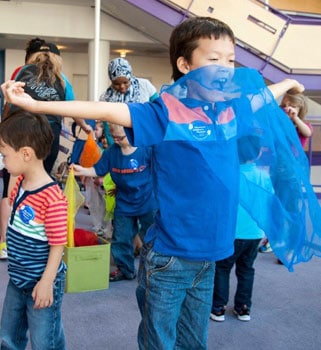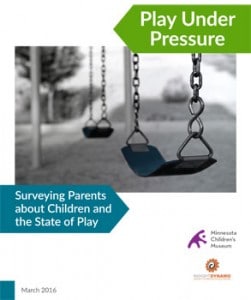Survey Says: Hectic Family Schedules Crowd Out Play Time
%
Parents who wish kids had more time for play
The Fix? Let’s Remember that More Play Means More Learning
Minnesota Children’s Museum surveyed more than 1,000 parents and other caregivers in the Twin Cities. We asked about play, learning and the factors that put a squeeze on a family’s time.
Does your family have a hectic schedule? Do you wish your kids could spend more time playing? Do you wonder whether you’re doing all you can to help your child succeed in school? If you say “Yes” to any of those questions, you’ve got a lot of company.
At the Museum, our message is this: Make play a priority.
Through play, children learn the skills they need to thrive now and throughout their lives. When children play, the learning sticks. Play makes our children and the entire community happier, healthier and more innovative.
Key Findings
Parents see the benefits of play…
- Agree that children develop important skills when they play on their own 87%
- Agree that unstructured, child-directed play is important to their child’s development 93%
But families face a variety of pressures…
- Worry child will “fall behind” without lessons and organized activities 45%
- Feel pressure to get child ready to succeed in school 61%
- Agree that kids spend too much time with electronic devices 88%
Which means play time often gets crowded out…
- Believe children don’t get enough time to play 70%
- Played more as a kid than their own children 82%
- Busy family schedule
- Lack of playmates nearby
- Outdoor safety worries
- Homework
- Screen time
What You Can Do

-
-
Give children time and space to play
-
Make play time a priority
-
Value the benefits of play
-

Details & Acknowledgements
Minnesota Children’s Museum partnered with InsightDynamo, a consumer insights firm, to survey Twin Cities parents about play. More than 1,000 adults in the Minneapolis-St. Paul metropolitan area completed the survey, which was conducted via an online survey platform. Respondents were recruited from a pool of general consumers and members of Minnesota Children’s Museum. The Museum and InsightDynamo developed the survey questions with input from the Minnesota Children’s Museum Research Advisory Council, a panel created in partnership with the Institute of Child Development at the University of Minnesota.

Minnesota Children’s Museum thanks the partners that helped develop, conduct and analyze this survey. Michael Brousseau, partner and CEO of InsightDynamo, provided valuable expertise and offered extensive pro bono services. Members of the Museum’s Research Advisory Council gave important input on the content and wording of the survey questions. Dr. Megan Gunnar, director of the Institute of Child Development at the University of Minnesota and chair of the Research Advisory Council, helped the Museum analyze results and provided context for the findings.
